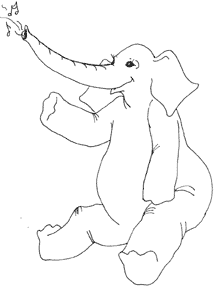Sounding off: Elephants ape surroundings

DRAWING BY DEBORAH DERR McCLINTOCK
Q. What just might be some of the strangest sounds elephants make in the wild? Or in a zoo, for that matter. –M. Perkins
A. When elephant communication researcher Joyce Poole was told of an odd noise by orphaned African elephant Mlaika, she recorded a low-pitched sound that continued for hours after sunset, says Science News. Playing it back, Poole was struck by its similarity to the low sound of trucks on the Nairobi-Mombasa highway three kilometers away. Often the two were indistinguishable. She later heard of a 23-year-old African elephant that made unusual chirpy sounds, typical for Asian elephants with whom he had lived for 18 years in a Swiss zoo. Statistical analyses confirmed the two sounds were indeed imitations!
Then there was the old Asian elephant that could angle up her trunk and blow through it to whistle. "A younger one watched, touched the outstretched trunk, and picked up the knack," says Poole. It just might be, say the researchers, that for complex social animals such as elephants, bats, birds, etc., mimicry and vocal learning are critical to their lifestyle.
Q. Major league baseball player reports chronic back pain throughout his career stemming from one leg being longer than the other. How common is this? Can it ever be an advantage in some sports? –J. Post
A. Leg length discrepancy (LLD) of less than 1 cm (.4 inch) is not uncommon and is not a problem, says Cornell orthopaedic surgeon S. Robert Rozbruch, director of the Institute for Limb Lengthening and Reconstruction. More than that can cause lower back curvature and pain, or a tilted pelvis and hip pain. LLD can be corrected with either a shoe lift or surgery to alleviate pain and prevent arthritis.
"If there is an associated deformity, this is corrected at the same time," says Rozbruch. Not surprisingly, patients undergoing total joint replacement of the hip or knee may end up with one shorter limb, because of the difficulty of positioning the implant, says Penn State kinesiologist and orthopaedic researcher Neil A. Sharkey.
As for athletic advantage, for a high jumper it might be good for the takeoff leg (usually the left) to be longer, permitting higher body positioning and a longer push-off, says Indiana University kinesiologist Jesus Dapena. Drawbacks include more difficulty gaining speed in the run- up and possible injury over the long term.
Limb-lengthening has become a hot science, with the bone cut and tugged and new bone growing in the gap, says Rozbruch. While this can be abused by guys 5'6" wishing to be 5'9, most of these surgeries have been done responsibly.
Q. "Women are more like each other than men," said Lord Chesterfield (1694-1773). What proof did he offer? –R. Richards
A. What he really demonstrated is our very human tendency to see people in a group (or grouped together by others) as being more uniform than they are, says David G. Myers in Social Psychology. If you think of an assemblage of people as being all athletes, or truck drivers, or teachers... this exaggerates the similarities within those groups and the differences between them. "They" seem "all alike" and different from "us," and because we naturally like those who are like us, an "ingroup bias" results.
Many non-Europeans see the Swiss as homogeneous, who see themselves as encompassing a diversity of French-, German-, and Italian-speaking groups, says Myers. Many Anglo-Americans lump "Latinos" together, while Mexican Americans, Cuban Americans, and Puerto Ricans see important differences.
So Lord Chesterfield may well have believed his statement about women, but it's doubtful Lady Chesterfield was consulted on the matter!
Send Strange questions to brothers Bill and Rich at .